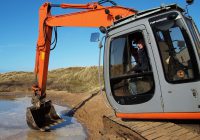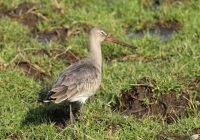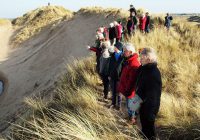Dr Phil Smith’s Wildlife Notes
February 2013
In complete contrast to the early winter period, no rain at all fell after 10th February, making this a relatively dry month. As a result, the record high water-level in the slacks began to fall, losing about three inches by the end of the month. This, together with a lot of engineering works to clear drains, meant that the Birkdale coastal road could finally be reopened.
Essential nature conservation management tasks are often done during the winter to avoid disturbing summer wildlife, such as nesting birds. During February, much needed scrub clearance took place at several places in the dunes. Natural England’s volunteers began the daunting task of opening up the Montagu Road triangle, a dune-heath site at Freshfield which used to have a wonderful display of Heather but has become sadly overgrown in recent years by young birch and pine. Meanwhile, Sefton’s Landscape Partnership team continued their excellent work to control scrub on the Birkdale Sandhills Local Nature Reserve. This included freeing up a south-facing slope which may be used to translocate Common Lizards from a development site. Finally, three patches of highly invasive Sea Buckthorn were removed from formerly botanically rich dune-slacks at Hightown.
Wetland work included digging new scrapes for Natterjack Toads at Ainsdale Sandhills and Hightown. These will be particularly useful in a drier period but with so much open water in the dunes this year we are hoping for a bumper breeding season.
February is often a quiet month for wildlife; nevertheless there was still plenty to see on the coast. A highlight at Ainsdale Beach on 4th was a Great Skua or Bonxie fighting its way out to sea against a fierce gale. Using my car as a hide, I was able to get really close to Black-tailed Godwits and Wigeon feeding next to Marshside Road on 12th. However, a later visit to Southport Marine Lake was disappointing as there were only about 70 Mute Swans and the same number of Coots. In previous winters, the lake has supported over 1000 Coots and 200+ swans, so it looks as though something has happened to their food supply, such as Beaked Tasselweed which is usually abundant here.
Insects are in short supply in February, so it was good to see a large, hairy Fox Moth caterpillar basking in the weak sunshine at Hightown on 14th. This species hibernates as a full-grown caterpillar and was particularly numerous last autumn. Nearby, a Grey Wagtail was foraging on the shingle beach, while the high-tide wader-roost held an impressively large flock of 750 Curlew. Another hairy duneland caterpillar, sometimes seen in winter, is the much smaller Ruby Tiger.Trevor Davenport and I were pleased to find four at Ainsdale Sandhills on 21st.
Guided walks are a great way for members of the public to find out more about the coast. I did two for the Landscape Partnership Scheme during the month, one to Devil’s Hole to look at the origin and development of this enormous blow-out and the other to Ainsdale Sandhills. Both were well attended, despite a cutting breeze. At Ainsdale, we climbed to the top of the highest dune ridge, giving dramatic views across well-flooded slacks to the shore, with Blackpool Tower and Black Combe just visible in the misty distance. A pleasant diversion from discussions on how slacks form was provided by a pair of Stonechats, this species having much declined recently due to cold winters.
A Bittern spent most of the month on Birkdale Sandhills slacks but the approach of spring was heralded by Avocets arriving at Martin Mere on 16th and Marshside on 27th. The most remarkable sighting, however, was a Swallow reported at Ainsdale and Birkdale on 28th. If confirmed, this will be the earliest of this species ever seen in Lancashire and North Merseyside, the previous record being 5th March 1918.




